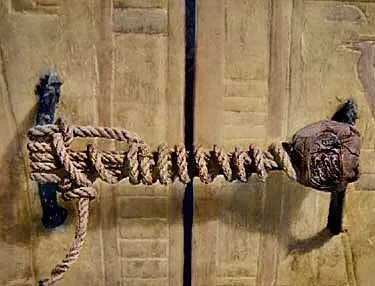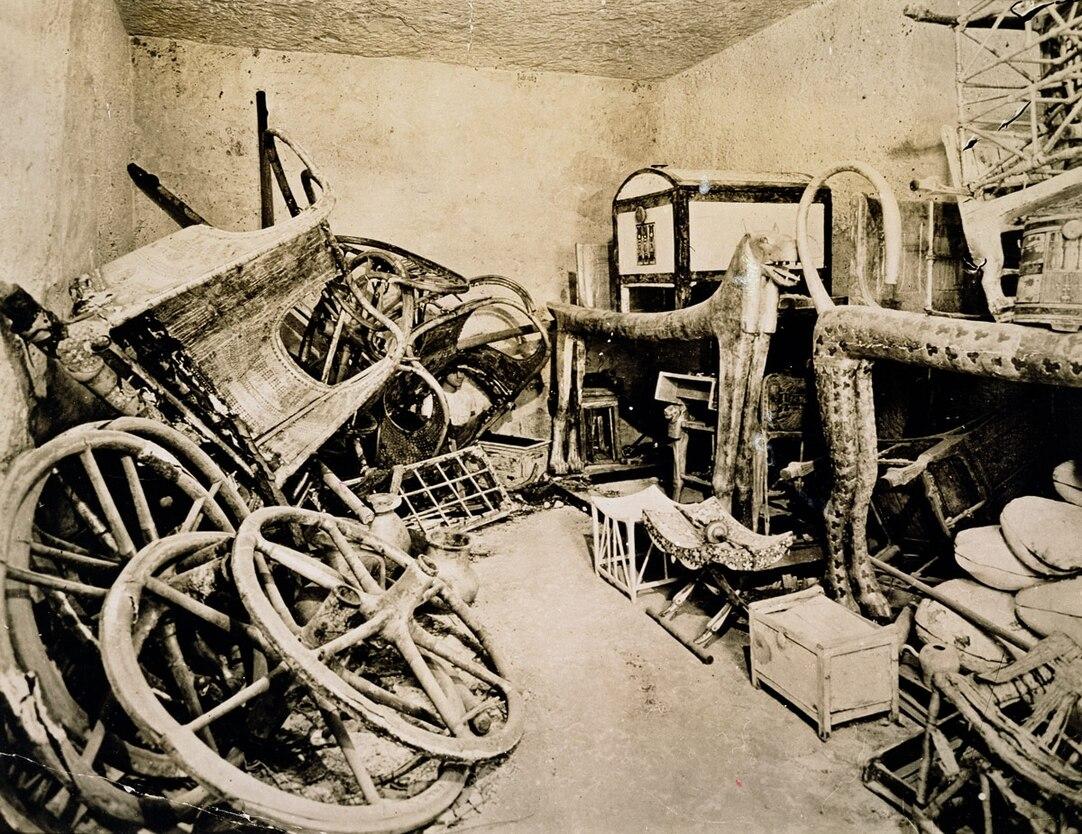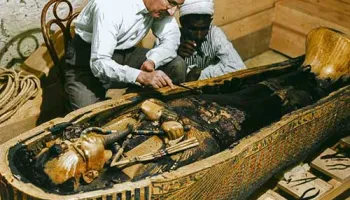The intact seal from King Tutankhamun’s tomb, 1922
 The intact seal in the tomb of King Tutankhamun, 1922.This seal was actually the seal of King Tutankhamun’s fifth shrine. The king was buried in a series of four sarcophagi, which were in turn kept within a series of five shrines. This intact seal remained intact for 3,245 years. The late discovery of Tutankhamun’s tomb was due to it being covered by remains from the tomb of Ramesses IV, which was located just above its entrance.Although the boy pharaoh’s outermost shrine had been opened not once but twice in ancient times, the doors of the second of the massive gilded wooden shrines containing the royal sarcophagus still bore the necropolis seal indicating that the pharaoh’s mummy was intact.
The intact seal in the tomb of King Tutankhamun, 1922.This seal was actually the seal of King Tutankhamun’s fifth shrine. The king was buried in a series of four sarcophagi, which were in turn kept within a series of five shrines. This intact seal remained intact for 3,245 years. The late discovery of Tutankhamun’s tomb was due to it being covered by remains from the tomb of Ramesses IV, which was located just above its entrance.Although the boy pharaoh’s outermost shrine had been opened not once but twice in ancient times, the doors of the second of the massive gilded wooden shrines containing the royal sarcophagus still bore the necropolis seal indicating that the pharaoh’s mummy was intact.
The boy king’s tomb was opened by the famous archaeologist and Egyptologist Howard Carter in the early 1920s. The tomb contained a treasure more spectacular than any previous discovery. Shortly after Howard Carter removed the lid of the outermost shrine of Tutankhamun’s burial chamber, he discovered three more.

Harry Burton photographed the ornately decorated doors of the second shrine, closed, their simple copper handles held firmly in place by a rope tied across them. The knotted rope was accompanied by a delicate clay seal depicting Anubis, the jackal god of the ancient Egyptians, who was entrusted with the protection of the cemetery.
Even from the beginning, Carter and his financier, Lord Carnarvon, knew that the tomb had been compromised because of a plastered and sealed hole in the outer door (not the fifth shrine).
Furthermore, once they entered the tomb, the disorganized state of the material, the damage suffered by several objects, and the noticeable lack of solid metal, linen, glass, oils and ointments, suggested that the tomb had been robbed during antiquity.
According to legend, he also found an ancient clay tablet in the antechamber. When he later translated it, the inscription read: “Death will slay with its wings whoever disturbs the peace of the Pharaoh.”

This curse would later become the famous “Curse of the Pharaohs,” which is actually nothing more than a myth. The curse, which does not distinguish between thieves and archaeologists, can supposedly cause bad luck, illness or death.
Tutankhamun was a very inconsequential king while he lived, however, because the tomb was located beneath an existing tomb and was never found by grave robbers, it became one of the most valuable archaeological finds.
Due to its lower position in the Valley of the Kings, the tomb’s entrance was sealed by rocks and flood mud and the location was lost until Carter’s discovery.
Tutankhamun was a relatively minor pharaoh who apparently died unexpectedly at a young age, so the wealth he was buried with (and which archaeologists discovered) was only a fraction of what it could have been had he lived a full life. So can you imagine the immense wealth that must have been buried with great pharaohs like Ramesses II?

How did the rope manage to last 3,200 years without deteriorating?
Rope is one of the fundamental human technologies. Archaeologists have discovered two-ply ropes dating back 28,000 years. Egypt was the first documented civilization to use specialized tools to make rope. One key to its longevity is not the rope itself, but the aridity of the air in the desert. It dries and preserves things.
Another key is the lack of oxygen. The tombs are sealed off from the outside. Bacteria can break down items as long as they have oxygen, but then they suffocate. It is not uncommon to find ropes, wood carvings, fabrics, organic dyes, etc. in Egyptian pyramids and tombs that would not have survived anywhere else in the world. The desert conditions of Egypt made it possible to preserve much more organic material than would have been possible otherwise.
This is in contrast to, for example, the Mayan sites in Central America, which are much more recent, but from which almost no organic material has been recovered. The main difference is the jungle conditions as opposed to the desert ones.






